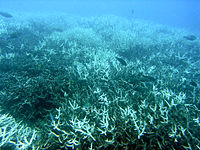
Photo from wikipedia
Coral reefs have been heavily affected by elevated sea-surface temperature (SST) and coral bleaching since the late 1980s; however, until recently coastal reefs of north-western Australia have been relatively unaffected… Click to show full abstract
Coral reefs have been heavily affected by elevated sea-surface temperature (SST) and coral bleaching since the late 1980s; however, until recently coastal reefs of north-western Australia have been relatively unaffected compared to Timor Sea and eastern Australian reefs. We compare SST time series with changes in coral cover spanning a period of up to 36 years to describe temporal and spatial variability in bleaching and associated coral mortality throughout the Pilbara–Ningaloo region. Declines in coral cover ranged from 12.5 to 51.3%, with relative declines ranging from 38 to 92%. Since 2013, coral cover throughout the region has declined to historically low levels at four of five subregions, with impaired recovery occurring at two subregions. Observations are consistent with global trends of repeated severe heat waves, coral bleaching and acute declines in coral cover. Locations within this study region have already experienced multiple coral-bleaching events within a period of less than 5 years. There is a high likelihood that reefs in the western Pilbara and northern Ningaloo regions will experience more frequent marine heatwaves, coral bleaching and mortality events in the future. Action, therefore, needs to be taken now to support the resilience of coral reef ecosystems in the region, which is arguably the most important coral-reef province on Australia’s western coast.
Journal Title: Marine and Freshwater Research
Year Published: 2020
Link to full text (if available)
Share on Social Media: Sign Up to like & get
recommendations!